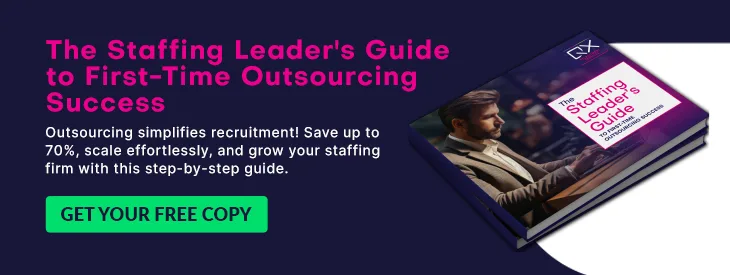Topics: Recruitment Outsourcing, Recruitment Outsourcing Services, Time-to-Fill
Recruitment Outsourcing: The Answer to Shorter Time-to-Fill
Posted on July 25, 2024
Written By Ranjana Singh

According to SHRM, the average time to fill a vacant position in the US, from job requisition approval to candidate acceptance, is about 44 days. However, this number varies widely across industries. For instance, filling a healthcare position often takes longer than other sectors.
The time to fill a position can range from as few as 14 days to as many as 63 days, depending on the industry. Some organizations can even fill positions on the same day they open. This variability highlights the importance of staffing firms setting their own recruitment turnaround benchmarks.
Research provides additional insights:
- LinkedIn: Only 30% of companies can fill vacancies within 30 days, while 70% take between 1 to 4 months to make a new hire.
- Workable: Notes that North America’s IT/Technology industry has a time to hire of 30 days, while the global average time to fill in Engineering is 62 days.
How long is too long? An infographic by Robert Half shows that 39% of over 1,000 U.S. workers polled said 7-14 days is too long; 23% will wait just one week to hear back from a company, while 57% lose interest in a long hiring process.
These stats highlight that the primary goal of every staffing firm is to reduce the time it takes to find and onboard the right candidate quickly. Why is this so crucial and how can recruitment outsourcing services help? Let’s discuss this in detail in the blog.
The Shorter the Time to Fill, the Better: Why It Matters?

Time to fill (TTF) is a crucial KPI that recruiters need to keep an eye on to boost their overall performance. Here’s why it is important:
- Spotting Inefficiencies: By tracking TTF, recruiters can identify what’s slowing down their hiring process. This helps simplify everything and prevents losing great candidates to faster-moving competitors.
- Better Hiring Decisions: When the hiring process drags on, it can hurt the quality of the hires. Speeding things up means you get top talent before they go elsewhere.
- Cutting Costs: The longer it takes to fill a position, the more it costs. This includes everything from advertising and recruiter salaries to potential overtime for current employees covering the vacancy.
- Boosting Productivity: An empty role means less productivity, lost revenue, and more stress on the current team. Filling positions quickly keeps things running smoothly.
- Improving Candidate Experience: A long TTF can be frustrating for candidates. Waiting weeks or months for feedback can make them lose interest or accept other offers, leaving them with a bad impression of your company.
- Attracting Top Talent: Efficient hiring processes make your company more appealing to top talent. When candidates get quick offers, they feel valued and appreciated, which can lead to higher engagement and productivity once they start.
In short, reducing TTF isn’t just about speeding things up. It’s about making your recruitment process more effective, keeping candidates happy, and maintaining productivity in your organization.
What Influences Recruitment Time-to-Fill?
Several factors can impact the time to fill (TTF) in recruitment. Here are some key elements to consider:
- Recruitment Process: The length and complexity of your recruitment process play a significant role. A cumbersome and lengthy process can prolong TTF, leading to missed opportunities and higher costs.
- Candidate Pool: The size and quality of the candidate pool also affect TTF. A small or limited pool can make it harder to find the right candidate, while a large pool can extend the recruitment process as more candidates need to be screened.
- Job Market: The state of the job market is another crucial factor. In a tight job market with fewer qualified candidates available, it can take longer to fill positions.
- Hiring Manager Involvement: The level of involvement from hiring managers can significantly influence TTF. If hiring managers are not actively engaged, the process can slow down.
- Internal Processes: Internal processes such as approvals and background checks can also impact TTF. Any delays in these areas can extend the time it takes to fill a position.
Also Read: How Automation Plus People is the Future Recruitment Outsourcing
How to Reduce Time to Fill?

Reducing Time to Fill (TTF) can help companies hire top talent quickly, improve the candidate experience, and save on recruitment costs. Here are some effective strategies:
- Optimize Recruitment Process: Simplify and streamline the recruitment process by eliminating unnecessary steps. Utilize technology to automate stages like resume screening and interview scheduling.
- Enhance Candidate Pool: Attract more qualified candidates by leveraging multiple sourcing channels and building a strong employer brand. Maintain relationships with passive candidates to ensure a steady pipeline of potential hires.
- Improve Communication: Maintain regular and transparent communication with candidates to keep them engaged and interested in the role.
- Train Hiring Managers: Ensure hiring managers understand the recruitment process and their role within it. Proper training can reduce delays and speed up the TTF.
- Leverage Data: Analyze recruitment data to identify bottlenecks and areas for improvement. Use these insights to refine your recruitment strategies and processes.
How Recruitment Outsourcing Can Help You Decrease Time to Fill?
Outsourcing your recruitment needs to an expert offshore recruitment service provider like QX Global Group can be a strategic solution to tackle the high time-to-fill challenge. Here’s how we can help:
- We’ve achieved a 60% fill ratio in just 6 months for our clients.
- Our strategies have lowered the offer backout rate to less than 1%.
- We maintain an impressive 4:1 submission to interview ratio.
- We’ve helped clients cut average hiring costs from $2500 to $1200.
- We develop comprehensive databases of doctors and nurses.
- Gain access to premium job boards.
- We use cutting-edge tools and data analytics for efficient recruitment.
How can we be sure of these numbers? Because we have achieved these results for our clients, and we can do the same for you. At QX, we specialize in offshore recruitment services tailored for healthcare staffing companies like yours. Our goal is to help you fill positions faster without compromising quality. So, what are you waiting for? Fill in your details in the form below, and an expert from our team will contact you soon.
Book a Free Consultation
Enjoyed our blog? Discover more about how our recruitment outsourcing process can slash your costs by up to 60%! Take the next step—book a call by entering your details.
Originally published Jul 25, 2024 09:07:52, updated May 13 2025
Topics: Recruitment Outsourcing, Recruitment Outsourcing Services, Time-to-Fill








